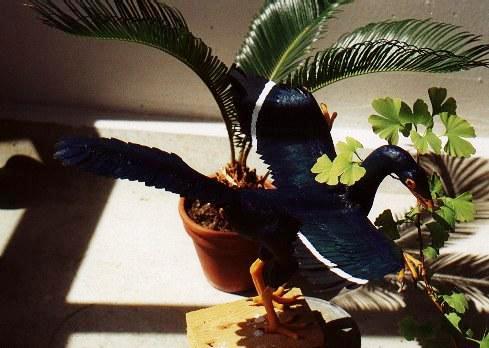
Crocodile of the Nile
My first work using papier maché since primary school. It was made in 1982 in about a week.It is 60 cm long constructed on a longitudinal piece of wood with wires protruding into the legs. The skin was sculptured with a plastic fork. It was painted with guache (which most danes prefer to call "tempera") and lacquered.
Flying reptile - pterandon, Cretaceous , 90 mill. years ago
I made this one in 1983 on a skeleton of bamboo. I was lucky to find two curved sticks for the long finger of the wings. The other fingers are made from pipe cleaners (not a great success). Were I to build another one its breast musculature would be stronger. The wingspan is 163 cm. Painted with guache and lacquered.

Mummified hand
A rather macabre thing in natural size (inspired by a short story by William Fryer Harvey: The Hand ) It is built on a wire skeleton soldered together. The veins on the back are strings of light blue cotton placed side by side. The nails are made of smooth drawing papier pressed into shape when wet. The skin is toilet paper that produce a wrinkled surface. It was painted with guache, dirt "under" the nails was drawn with a pencil and the figure was coated with schellac (not to glossy). Around 1985.Butterfly - Agrias sardanapalus
Wing span 85 cm. It is not a complete success (the body is not right and the wings are to weak) The head was made using another technique. It was modelled in plasticine and covered with very narrow strips of tissue paper. When dry the plasticine was removed from the neck.The head was coated with gesso (this time from PVA-glue and chalk) and dots representing the individual ommatidia were added. The antennae are partly burned pipe cleaners with a tip from gesso. Made around 1985-1986.


Duck-billed lizard - anatosaurus
Cretaceous, 70 mill. years ago
132 cm high. This dinosauer
was built upon a skeleton looking a little like the real skeleton. The
body was then built from crumbled papers and strips of newspaper until
the shape was good. Then it was coated with a thick layer of pulp in wich
I modelled various wrinkles and scales. Bony nodes were added to the skin
of the back. Its claws, a sort of hoofs, were cut from wood (otherwise
the might easily break). The head was not mounted until late in the process
so as to make working on the head easy (I could sit on a chair). Then the
neck was finished. Working on the body implied sitting on my
knees or lying on my back for hours.
The eyes were made from plexiglass and painted from the back. The dinosauer was painted with artists oil colours to make it less glossy. Some of the paint was applied using my hand as a brush.
This model was made in 1990 - 91. It took a lot of work as I didn't know the trick of making pulp using a paint stirrer so I ground all of it between two stones!
Should I make this dinosauer today the face would look different and the posture would be less erect.

Ichthyosaurus
Upper Jurassic, 125 mill. years ago
This model was built in 1993 - 94. It is 112 cm long.
It was built on a wooden skeleton with paddles cut from plywood. The "bones" of the skull were cut with much care for detail.The teeth are made from a plastic that hardens when heated (Cernit).The eyes were cut from plexiglass with a coloured layer sandwiched between the front lens and a hemispherical reflector. Thus the eyes glow in the dark like a cat when hit by a ray of light. The tongue was cast from pulp in a mould made from plaster of Paris. That mould was cast on a model of plasticine. Another technique for your use.
The figure was sanded smooth (it produces a lot of dust, better use a mask) and coated withe several layers of gesso and sanded between the layers. The gesso was coated with schellac and then the figure was painted using artist oil colours (a fish does not look wet when under the surface).



Cacops - a small amphibian from Lower Permian, 220 mill. years ago
This model is only 35 cm long, its natural size (I am running out of space in my apartment). The skeleton was made from wire and cardboard. The feet were cut from bone (don't throw out the bones when making soup). Toilet paper makes a nice skin. Bony nodes (made from papier maché, not bone) were added.Archaeopteryx - Jurassic, 150 mill. years ago
This jurassic bird, Archaeopteryx Litografica, is my latest product (2000). It is in natural size, somewhat like a longlegged pigeon. It is remarkable by having teeth and clawy fingers. The bird lacks a sternum which might have reduced its power of flight.The model is built on a skeleton of wire with a plug of wood for the hip and another for the shoulder parts (you can easily glue the wire parts into small holes in the wood). Legs and fingers were modelled in Cernit, but on a skeleton of wire. Otherwise they would bend or break. The claws were cut out of horn using a difference in colouration to make them look real. Its teeth and jaws are cut from bone. Teeth of cernit would break even before hardening. The big feathers are cut from drawing papir.
Since the time of photography it has been mounted on a proper wooden plate.



